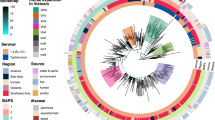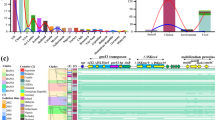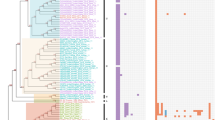Abstract
The origin of multidrug-resistant Salmonella enterica serovar typhimurium (S. typhimurium) harboring the Salmonella Genomic Island 1 (SGI1), which was detected for the first time in the mid-1980s is unknown. In this study, we performed microarray genomotyping of four multidrug-resistant SGI1 positive strains and found that unlike the S. typhimurium LT2 strain, the multidrug-resistant strains lacked genes STM0517-0529 allowing the utilization of allantoin as a sole nitrogen source. We extended this observation by PCR screening of additional 120 S. typhimurium field strains and found that this locus was absent in all SGI1 positive and also in 24% of SGI1 negative strains, which were proposed to be the original recipients of SGI1. To prove this hypothesis, we compared the STM0517-0529 negative strains (with or without the SGI1) by PFGE and PCR prophage typing and found that 8 out of 11 of the SGI1 negative strains and 17 out of 22 SGI1 positive strains were of identical PFGE pattern and PCR prophage pattern, while this specific pattern was never observed among STM0517-0529 positive strains. We therefore propose that a lineage of the S. typhimurium DT104 sensitive strain first lost the ability to metabolize allantoin and then acquired SGI1.



Similar content being viewed by others
References
Allen CA, Fedorka-Cray PJ, Vazquez-Torres A, Suyemoto M, Altier C, Ryder LR, Fang FC, Libby SJ (2001) In vitro and in vivo assessment of Salmonella enterica serovar typhimurium DT104 virulence. Infect Immun 69:4673-4677
Anderson ES, Ward LR, Saxe MJ, de Sa JD (1977) Bacteriophage-typing designations of Salmonela typhimurium. J Hyg (Lond) 78:297–300
Anriany YA, Weiner RM, Johnson JA, de Rezende CE, Joseph SW (2001) Salmonella enterica serovar typhimurium DT104 displays a rugose phenotype. Appl Environ Microbiol 67:4048–4056
Boyd D, Peters GA, Cloeckaert A, Boumedine KS, Chaslus-Dancla E, Imberechts H, Mulvey MR (2001) Complete nucleotide sequence of a 43-kilobase genomic island associated with the multidrug resistance region of Salmonella enterica serovar typhimurium DT104 and its identification in phage type DT120 and serovar Agona. J Bacteriol 183:5725–5732
Boyd D, Cloeckaert A, Chaslus-Dancla E, Mulvey MR (2002) Characterization of variant Salmonella genomic island 1 multidrug resistance regions from serovars typhimurium DT104 and Agona. Antimicrob Agents Chemother 46:1714–1722
Carlson SA, Willson RM, Crane AJ, Ferris KE (2000) Evaluation of invasion-conferring genotypes and antibiotic-induced hyperinvasive phenotypes in multiple antibiotic resistant Salmonella typhimurium DT104. Microb Pathog 28:373–378
Carlson SA, McCuddin ZP, Wu MT (2005) SlyA regulates the collagenase-mediated cytopathic phenotype in multiresistant Salmonella. Microb Pathog 38:181–187
Chan K, Baker S, Kim CC, Detweiler CS, Dougan G, Falkow S (2003) Genomic comparison of Salmonella enterica serovars and Salmonella bongori by use of an S. enterica serovar typhimurium DNA microarray. J Bacteriol 185:553–563
Cusa E, Obradors N, Baldoma L, Badia J, Aguilar J (1999) Genetic analysis of a chromosomal region containing genes required for assimilation of allantoin nitrogen and linked glyoxylate metabolism in Escherichia coli. J Bacteriol 181:7479–7484
Doublet B, Lailler R, Meunier D, Brisabois A, Boyd D, Mulvey MR, Chaslus-Dancla E, Cloeckaert A (2003) Variant Salmonella genomic island 1 antibiotic resistance gene cluster in Salmonella enterica serovar Albany. Emerg Infect Dis 9:585–591
Doublet B, Boyd D, Mulvey MR, Cloeckaert A (2005) The Salmonella genomic island 1 is an integrative mobilizable element. Mol Microbiol 55:1911–1924
Evans S, Davies R (1996) Case control study of multiple-resistant Salmonella typhimurium DT104 infection of cattle in Great Britain. Vet Rec 139:557–558
Faldynova M, Pravcova M, Sisak F, Havlickova H, Kolackova I, Cizek A, Karpiskova R, Rychlik I (2003) Evolution of antibiotic resistance in Salmonella enterica serovar typhimurium strains isolated in the Czech Republic between 1984 and 2002. Antimicrob Agents Chemother 47:2002–2005
Garaizar J, Porwollik S, Echeita A, Rementeria A, Herrera S, Wong RM, Frye J, Usera MA, McClelland M (2002) DNA microarray-based typing of an atypical monophasic Salmonella enterica serovar. J Clin Microbiol 40:2074–2078
Hermans AP, Abee T, Zwietering MH, Aarts HJ (2005) Identification of novel Salmonella enterica serovar typhimurium DT104-specific prophage and nonprophage chromosomal sequences among serovar typhimurium isolates by genomic subtractive hybridization. Appl Environ Microbiol 71:4979–4985
Hunter SB, Vauterin P, Lambert-Fair MA, Van Duyne MS, Kubota K, Graves L, Wrigley D, Barrett T, Ribot E (2005) Establishment of a universal size standard strain for use with the PulseNet standardized pulsed-field gel electrophoresis protocols: converting the national databases to the new size standard. J Clin Microbiol 43:1045–1050
Hupe P, Stransky N, Thiery JP, Radvanyi F, Barillot E (2004) Analysis of array CGH data: from signal ratio to gain and loss of DNA regions. Bioinformatics 20:3413–3422
Matiasovicova J, Faldynova M, Pravcova M, Karpiskova R, Kolackova I, Damborsky J, Rychlik I (2003) Retron reverse transcriptase rrtT is ubiquitous in strains of Salmonella enterica serovar typhimurium. FEMS Microbiol Lett 223:281–286
McClelland M, et al. (2001) Complete genome sequence of Salmonella enterica serovar Typhimurium LT2. Nature 413:852–856
Meunier D, Boyd D, Mulvey MR, Baucheron S, Mammina C, Nastasi A, Chaslus-Dancla E, Cloeckaert A (2002) Salmonella enterica serotype typhimurium DT 104 antibiotic resistance genomic island I in serotype Paratyphi B. Emerg Infect Dis 8:430–433
Mikasova E, Drahovska H, Szemes T, Kuchta T, Karpiskova R, Sasik M, Turna J (2005) Characterization of Salmonella enterica serovar typhimurium strains of veterinary origin by molecular typing methods. Vet Microbiol 109:113–120
Pilousova L, Matiasovicova J, Sisak F, Havlickova H, Rychlik I (2005) Retron reverse transcriptase (rrtT) can be lost in multidrug resistant Salmonella enterica serovar typhimurium DT 104 strains and influences virulence for mice. Vet Microbiol 111:191–197
Porwollik S, McClelland M (2003) Lateral gene transfer in Salmonella. Microbes Infect 5:977–989
Porwollik S, Wong RM, McClelland M (2002) Evolutionary genomics of Salmonella: gene acquisitions revealed by microarray analysis. Proc Natl Acad Sci USA 99:8956–8961
Porwollik S, Boyd EF, Choy C, Cheng P, Florea L, Proctor E, McClelland M (2004a) Characterization of Salmonella enterica subspecies I genovars by use of microarrays. J. Bacteriol 186:5883–5898
Porwollik S, Wong RM, Helm A, Edwards KK, Calcutt M, Eisenstark A, McClelland M (2004b) DNA amplification and rearrangements in archival Salmonella enterica serovar typhimurium LT2 cultures. J Bacteriol 186:1678–1682
R Development Core Team (2004) A language and environment for statistical computing. R Foundation for Statistical Computing. Vienna, ISBN 3-900051-00-3. URL http://www.R-project.org
Reen FJ, Boyd EF, Porwollik S, Murphy BP, Gilroy D, Fanning S, McClelland M (2005) Genomic comparisons of Salmonella enterica serovar Dublin, Agona, and typhimurium strains recently isolated from milk filters and bovine samples from Ireland, using a Salmonella microarray. Appl Environ Microbiol 71:1616–1625
Ross IL, Heuzenroeder MW (2005) Discrimination within phenotypically closely related definitive types of Salmonella enterica serovar typhimurium by the multiple amplification of phage locus typing technique. J Clin Microbiol 43:1604–1611
Rychlik I, Gregorova D, Hradecka H (2006) Distribution and function of plasmids in Salmonella enterica. Vet Microbiol 112:1–10
Thomson N, Baker S, Pickard D, Fookes M, Anjum M, Hamlin N, Wain J, House D, Bhutta Z, Chan K, Falkow S, Parkhill J, Woodward M, Ivens A, Dougan G (2004) The role of prophage-like elements in the diversity of Salmonella enterica serovars. J Mol Biol 339:279–300
Threlfall EJ, Frost JA, Ward LR, Rowe B (1994) Epidemic in cattle and humans of Salmonella typhimurium DT 104 with chromosomally integrated multiple drug resistance. Vet Rec 134:577
Wall PG, Morgan D, Lamden K, Ryan M, Griffin M, Threlfall EJ, Ward LR, Rowe B (1994) A case control study of infection with an epidemic strain of multiresistant Salmonella typhimurium DT104 in England and Wales. Commun Dis Rep CDR Rev 4:R130–R135
Wit E, McClure J (2004) Statistics for microarrays: design, analysis and inference. Wiley, Chichester, 278, ISBN:0-470-84993-2. http://www.stats.gla.ac.uk/∼microarray/research.html
Wu MT, Carlson SA, Meyerholz DK (2002) Cytopathic effects observed upon expression of a repressed collagenase gene present in Salmonella and related pathogens: mimicry of a cytotoxin from multiple antibiotic-resistant Salmonella enterica serotype typhimurium phagetype DT104. Microb Pathog 33:279–287
Acknowledgments
The authors wish to acknowledge the assistance of Peter Sebo and Sarka Pospisilova for the introduction into microarray scanning and Frantisek Sisak for supplying the field strains. Technical assistance of Michaela Dekanova is also acknowledged. This work has been supported by the EU project 505523 and project MZE0002716201 of the Ministry of Agriculture of the Czech Republic.
Author information
Authors and Affiliations
Corresponding author
Rights and permissions
About this article
Cite this article
Matiasovicova, J., Adams, P., Barrow, P.A. et al. Identification of putative ancestors of the multidrug-resistant Salmonella enterica serovar typhimurium DT104 clone harboring the Salmonella genomic island 1. Arch Microbiol 187, 415–424 (2007). https://doi.org/10.1007/s00203-006-0205-6
Received:
Revised:
Accepted:
Published:
Issue Date:
DOI: https://doi.org/10.1007/s00203-006-0205-6




